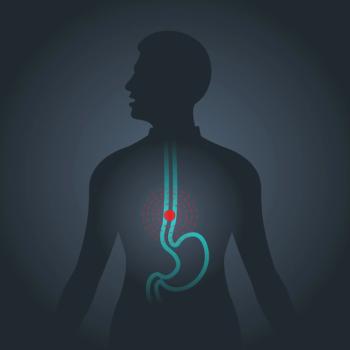
- ONCOLOGY Vol 21 No 9
- Volume 21
- Issue 9
Key Developments in Rectal Cancer Treatment
Epidermal growth factor receptor (EGFR) and vascular endothelial growth factor (VEGF) are often overexpressed in colorectal cancer and are associated with inferior outcomes. Based on successful randomized phase III trials, anti-EGFR and anti-VEGF therapeutics have entered clinical practice. Cetuximab (Erbitux), an EGFR-specific antibody, is currently approved in the United States in combination with irinotecan (Camptosar) for patients with metastatic colorectal cancer refractory to irinotecan or as a single agent for patients unable to tolerate irinotecan-based therapy. In retrospective analyses, patients with EGFR-expressing rectal cancer undergoing neoadjuvant radiation therapy had a significantly inferior disease-free survival and lower rates of achieving pathologic complete response. Based on the positive data in metastatic colorectal cancer and synergy with radiation therapy seen in preclinical models, there is a strong rationale to combine cetuximab with neoadjuvant radiation therapy and chemotherapy in rectal cancer. Bevacizumab (Avastin), a VEGF-specific antibody, was the first antiangiogenic agent to be approved in the United States for use in combination with standard chemotherapy in the first- and second-line of treatment in metastatic colorectal cancer. VEGF-targeted therapy may lead to indirect killing of cancer cells by damaging tumor blood vessels, and may increase the radiosensitivity of tumor-associated endothelial cells. VEGF blockade can also "normalize" tumor vasculature, thereby leading to greater tumor oxygenation and drug penetration. This review will address completed and ongoing trials that have established and continue to clarify the effects of these agents in rectal cancer.
In recent years, we have seen significant changes in the adjuvant management of rectal cancer. For example, total mesorectal excision (TME) is now the preferred surgical technique,[1] local failure is related not only to stage but also to the location of the tumor in the rectum and the status of the circumferential margin,[2] at least 12 nodes need to be examined to accurately determine the nodal stage,[3] and subsets of patients with pT3, N0 or pT1–2, N1 disease may not require postoperative radiation.[4] For patients with cT3 and or N+ disease, the German CAO/ARO/AIO 94 trial confirmed that preoperative combined-modality therapy significantly improves local control, with less acute and long-term toxicity, and increased sphincter preservation compared with postoperative combined-modality therapy.[5]
Parallel Developments
Paralleling the improvements in rectal cancer treatment, significant advances in systemic therapy for colon cancer have been introduced. Clinical trials have evolved from identifying the preferred method of administering and/or modulating fluorouracil (5-FU) therapy to more interesting questions. For example, numerous studies have investigated the impact of cytotoxic agents such as oxaliplatin (Eloxatin) and irinotecan (Camptosar) on response rate and survival, as well as the additional benefit of targeted therapies including bevacizumab (Avastin), cetuximab (Erbitux), gefitinib (Iressa), and panitumumab (Vectibix) when combined with 5-FU– or capecitabine (Xeloda)-based regimens.
In contrast to colon cancer, node-positive rectal cancer requires the addition of pelvic irradiation to systemic chemotherapy. This is due to the high local recurrence rate, which, even following TME, is at least 20%. As these cytotoxic and targeted agents are incorporated in the management of metastatic and adjuvant colon cancers, we need to understand how to safely and effectively combine them with pelvic radiation. Since 3-year disease-free survival is an acceptable endpoint for adjuvant colon cancer trials,[6] data have become available far more rapidly than in rectal cancer trials, providing a unique opportunity for clinical trial development, mostly in the preoperative setting.
Willett and colleagues present a comprehensive, articulate, and timely review of the combined-modality trials in rectal cancer incorporating these targeted agents. They address the rationale, possible mechanisms of action, and preliminary results of these investigations. Since most of the agents are radiosentisizers, careful phase I trials are required. These authors are leaders in clinical trial design as well as in the identification and evaluation of markers of response such as interstitial fluid pressure, tumor microvascular density, and 18F-fluorodeoxyglucose (FDG)-uptake.
Remaining Questions
Most phase I/II trials combining these new agents with pelvic irradiation report higher pathologic response rates compared with 5-FU alone. However, many questions remain. For example, do these higher response rates translate into improved local control and/or survival,[7] and are there molecular markers that can help predict which tumors will respond?[7] As the standard of care for rectal cancer has evolved from postoperative to preoperative combined-modality therapy, the identification of predictive markers has become an important component in the design of our clinical trials.
The combination of targeted agents and pelvic radiation is promising but investigational. I look forward to the results from Chris Willett's group and others, as we begin to understand the clinical outcome and molecular mechanisms of action involved in this treatment approach.
-Bruce D. Minsky, MD
References:
1. Kapiteijn E, Marijnen CAM, Nagtegaal ID, et al: Preoperative radiotherapy combined with total mesorectal excision for resectable rectal cancer. N Engl J Med 345:638-646, 2001.
2. Marijnen CAM, Nagtegaal ID, Kapiteijn E, et al: Radiotherapy does not compensate for positive resection margins in rectal cancer patients: Report of a multicenter randomized trial. Int J Radiat Oncol Biol Phys 55:1311-1320, 2003.
3. Tepper JE, O'Connell MJ, Niedzwiecki D, et al: Impact of number of nodes retrieved on outcome in patients with rectal cancer. J Clin Oncol 19:157-163, 2001.
4. Gunderson LL, Sargent D, Tepper JE, et al: Impact of T and N stage and treatment on survival and relapse in adjuvant rectal cancer: a pooled analysis. J Clin Oncol 22:1785-1796, 2004.
5. Sauer R, Becker H, Hohenberger P, et al: Preoperative chemoradiotherapy as compared with postoperative chemoradiotherapy for locally advanced rectal cancer. N Engl J Med 351:11-20, 2004.
6. Sargent DJ, Wieand HS, Haller DG, et al: Disease-free survival versus overall survival as a primary end point for adjuvant colon cancer studies: Individual patient data from 20,898 patients on 18 randomized trials. J Clin Oncol 23:8664-8670, 2005.
7. Johnston PG: Prognostic markers of local relapse in rectal cancer: Are we any further forward? J Clin Oncol 24:4049-4050, 2006.
Articles in this issue
over 18 years ago
Red Wine Protects the Prostate, Seattle Investigators Reportover 18 years ago
Role of Stem Cell Transplant in Pediatric CancersNewsletter
Stay up to date on recent advances in the multidisciplinary approach to cancer.




















































































